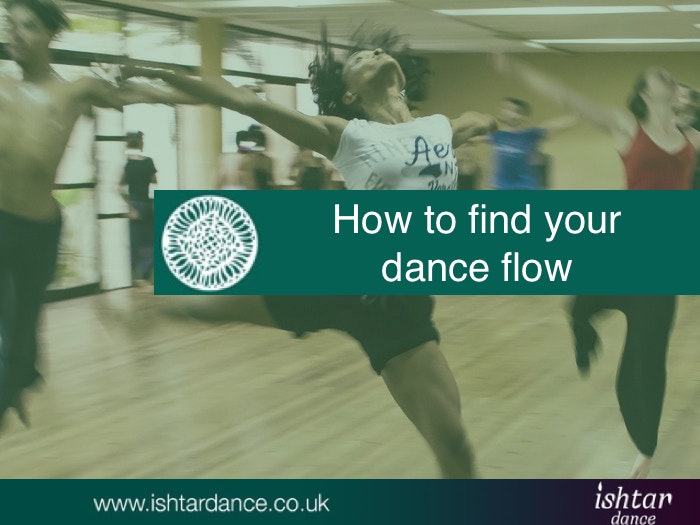How to find your dance flow
By Ishtar Dance on Monday, November, 19th, 2018 in Dance Coaching, Dance Inspiration, Learning, Your Dance Body No Comments

Have you ever found yourself in a situation or environment where all of a sudden everything just went so smoothly and you completely lost track of time? That you got totally absorbed in the here and now? That’s the flow I’m talking about, and it’s essential to find it in your dancing too, to allow yourself to melt into the moment.
The scientific bit
There are many different kinds of flow, but it’s scientifically proven and it’s no surprise that they studied in particular creative people to formulate it. Flow is scientifically expressed as:
- Being completely in the moment, focussed and concentrated.
- A sense of ecstasy – being outside everyday reality.
- Having a greater inner clarity and knowing what you need to do from one moment/movement to the next.
- Knowing that its do-able and that your skills are adequate even if you’re finding it difficult.
- A sense of serenity – that time disappears and that you’re part of something bigger than you (growing beyond the boundaries of your own ego).

The graph above, ‘mental state diagram’ is based on Csikszentmihalyi’s flow model (adapted from Wikipedia). It can be used to predict fairly accurately when a person is in flow. Everyone’s skills and capabilities are obviously different, but based on this, everyone’s “average’ is in the centre, where skills meets the challenges. You will be in flow once your challenges and skills are higher than your average. You may be doing things very differently to others, but you’ll be lost in the moment as you’re doing what you truly love to do. Low skills and challenges on the other hand lead to apathy, and low skills and high challenges to anxiety – something that can prove itself for novice dancers and performers, although other aspects may also affect this. It should come as no surprise that we’re the happiest when we’re in the state of flow.
“Being completely involved in an activity for its own sake. The ego falls away. Time flies. Every action, movement, and thought follows inevitably from the previous one, like playing jazz. Your whole being is involved, and you’re using your skills to the utmost,” Mihaly Csikszentmihalyi.
When in flow you are ‘over-challenged’ and therefore aroused, which keeps you focussed, and even if your skills may not be quite there yet, they can easily be developed to make you achieve what you’re working towards. This is when people really develop and learn, because it’s something that captivates them, and although we all like to be in control, when we feel safe and secure, there are no big sparks will give you that fire and passion to truly develop you further.
I came across a great TED talk video that explains more about this – view it here.
How does flow impact on your dancing?
Dance flow can be viewed very different, but in many ways it’s exactly the same as explained above.
There is obviously the flow of the movement itself, making it a continues experience, but there’s also the feeling of being ‘in flow’, in the zone, and surrendering yourself to both the music and the movement.
When I teach dance and performance flow, I often talk about it coming ‘from the heart’. That you have to ‘mean, feel and enjoy’ the quality of the movement, not just executing it. Dancers have to melt into the three m’s: moment, movement and music. To do so, you need to have good technique to support you (see diagram above), but also the confidence and knowledge to deliver a good performance and ideally loose yourself in the fun of it.
Going back to the scientific theory above, this can be summed up as follows :
- Your dance should be a challenge but still meet your abilities and skill.
- Have complete focus on the task – or in the case of dancing – the music.
- Have faith in your own control over the moment, movement and the final outcome of your actions (your dance/performance).
- Loose your inhibitions and forget what it may look like to others.
- Do it for yourself – not to please others or receive external gratification. Yes, we want it to look good, but you should do what you feel is right and not what you think others want.
So how can you achieve all this, when you’re also busy listing to the music, thinking about what moves you know, breath, not fall over, smile! Well, we all know there’s a lot of stuff to think about, but that is exactly the point – you have to have faith in the fact that you can do all this basic stuff already. If not, you will have to keep practising with the right feedback and guidance to support your learning and skills – not in a vacuum or on your own.
You can’t force flow, but there are elements that in my experience can help you to further your development to get into or maintain it:
Do your home work: Keep working on polishing your technique, learning combinations and practise. If you’re working on a choreography/performance listen to your music, move to your music and keep exploring it, until you feel you know it inside out.
Challenge yourself: Remember – it’s meant to be ‘just’ hard enough for you to get into ‘flow’. It will help develop you and become a better dancer all-round.
Do it for you: Forget about others, and do it because you love that piece of music, the steps/ choreography or what ever it is that has inspired you to do the dance.
Keep moving: Not necessarily literally, as all dances need some stillness. But focus on the movement in your body and how it feels. Even a breath to pause is movement!
Trust your instincts: Have faith in the fact that you have done the hard work and know your stuff. If you’re not sure – go back to point one and work on developing those skills, which may be technique, music, style or history knowledge, in order to feel confident with the movements.
All of this is of course highly subjective, and different people may approach it differently, so find a path that rings right with you and have fun exploring your dance and performance flow!
If you’d like to work more on this with me, then join me for a ‘live’ Phrasing and Flow workshop on Sunday 25 November 11:30-13:30 at the River Bourne Club, Chertsey, Surrey.
How do you get into flow? What may distract you or prevent you from it? How do you help others to achieve it? Please leave me a comment below so we can keep the knowledge sharing going and encourage beautiful and fully flowing dancing 😉
Happy dancing – always!
Dorte
Did you miss my last post? Read it here: How to do a basic shifting hip circle

Leave a Reply